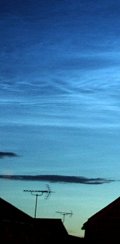| |
Observing
tips: Look
west 30 to 60 minutes after sunset when
the Sun has dipped 6o to 16o below the horizon.
If you see luminous blue-white tendrils spreading across the sky,
you've probably spotted a noctilucent
cloud. Although
noctilucent clouds appear most often at arctic latitudes, they have
been sighted in recent years
as far south as Colorado, Utah and Virginia. NLCs are seasonal,
appearing most often in late spring and summer. In the northern
hemisphere, the best time to look would be between mid-May and the
end of August. See also 2003,
2004, 2005,
2006 and 2007. |
 |
| |
| |
Photographer,
Location |
Images |
Comments |
|

[movie]
|
Torcuill Torrance,
Newtonhill, Aberdeenshire, UK
Jun. 19, 2008 |
#1,
#2,
#3,
more
Bonus:
5 MB movie. |
Beautiful flood
of NLC. Taken using Canon
350D (astro modded) at f/5.6 and a Phottix intervalometer
set for one frame per minute |
|

|
John
C McConnell,
Maghaberry Northern Ireland.
Jun. 20, 2008 |
#1,
#2 |
The
NLC season just gets better every night here in Northern
Ireland.This was a great show this morning with a very extensive
dislpay reaching right across the sky from NW to NE, it
was the best so far with hopefully more to come.
Photo
details: Canon
400D, ISO400, 8 seconds at f5.6. |
|

|
Conor McDonald,
Northern Ireland, Co.Derry, Maghera
Jun. 21, 2008 |
#1,
#2, #3,
#4 |
Last night's
display was truly amazing, the complex twists and crosses
were as good as I have ever seen them. |
|

|
Martin
Mc Kenna,
Maghera, Co. Derry, N. Ireland
Jun. 20, 2008 |
#1,
#2,
#3,
#4,
more |
This
was an incredible NLC display and without doubt the brightest
and most intense display of the 2008 season to date. It
was over 100 degrees long and 15 degrees high sporting stunning
silver bands and other complex structures. The display seemed
to change size and shape by the minute with other subtle
atmospheric colours such as electric blue, orange, and even
green. It was so bright it would have been spotted by members
of the public with even a casual glance. The highlight of
the 2008 season so far. I couldn't take my eyes away from
it!
Photo
details: Fuji
Finepix S6500fd 6.3MP at ISO100 and 5-6.6 sec exposures.
|
|

|
Paul Evans,
Larne, Northern Ireland, UK
Jun. 20, 2008 |
#1,
#2, #3,
#4, more |
This display
appeared quite suddenly out of the twilight - we had a clear
sky, - I looked out 10mins later and this display was appearing.
It was a low one - only 10deg above the horizon and 60 deg
wide, but probably the brightest I've ever seen.
Photo
details: Sony
A700, 16-105mm lens, 4secs at f5.6 |
more
images (June 20): from
Mike Alexander of Dumfries & Galloway, Scotland
|
|
|






